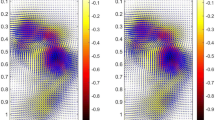Abstract
We perform a sensor-based velocity field estimation in the wake of a wall-mounted pyramid from experimental data. The velocity field is measured with time-resolved stereoscopic PIV, and the sensors monitor local surface pressure. Starting point is the extended proper orthogonal decomposition technique. Key enablers for the spatio-temporal resolution of the strongly modulated shedding are (1) the exploitation of cross-correlation between velocity field and pressure, (2) time-delayed sensor signals, (3) symmetry considerations and (4) guaranteed orthonormality of the velocity expansion modes. The combined filtering operations are shown to yield a near-optimal flow estimation from pressure signals. The residual of the estimated coherent kinetic energy is about 30–50 % smaller, and the mean-field paraboloid is better rendered than with the previously proposed estimation methods.















Similar content being viewed by others
References
Adrian RJ, Moin P (1988) Stochastic estimation of organized turbulent structure: homogeneous shear flow. J Fluid Mech 190:531–559
Borée J (2003) Extended proper orthogonal decomposition: a tool to analyse correlated events in turbulent flows. Exp Fluids 35:188–192
Bourgeois JA, Noack BR, Martinuzzi RJ (2013) Generalized phase average with applications to sensor-based flow estimation of the wall-mounted square cylinder wake. J Fluid Mech 736:316–350
Castro IP, Watson L (2004) Vortex shedding from tapered, triangular plates: taper and aspect ratio effects. Exp Fluids 37:159–167
Clark H, Naghib-Lahouti A, Lavoie P (2014) General perspectives on model construction and evaluation for stochastic estimation, with application to a blunt trailing edge wake. Exp Fluids 55:1756
Durgesh V, Naughton JW (2010) Multi-time-delay LSE-POD complementary approach applied to unsteady high-Reynolds-number near wake flow. Exp Fluids 49:571–583
Gaster M (1969) Vortex shedding from slender cones at low Reynolds numbers. J Fluid Mech 38:565–576
Holmes P, Lumley JL, Berkooz G, Rowley CW (2012) Turbulence, coherent structures, dynamical systems and symmetry. Cambridge Monographs on Mechanics, Cambridge
Hosseini Z, Bourgeois JA, Martinuzzi RJ (2013) Large-scale structures in dipole and quadrupole wakes of a wall-mounted finite rectangular cylinder. Exp Fluids 54:1595
Jeong J, Hussain F (1995) On the identification of a vortex. J Fluid Mech 285:69–94
Lasagna D, Orazi M, Iuso G (2013) Multi-time delay, multi-point linear stochastic estimation of a cavity shear layer velocity from wall-pressure measurements. Phys Fluids 25:017101
Martinuzzi RJ (2008) Dual vortex structure shedding from low aspect ratio, surface-mounted pyramids. J Turbul 28:1–16
Naguib AM, Wark CE, Juckenhofel O (2001) Stochastic estimation and flow sources associated with surface pressure events in a turbulent boundary layer. Phys Fluids 13:2611
Noack BR, Afanasiev K, Morzynski M, Tadmor G, Thiele F (2003) A hierarchy of low-dimensional models of the transient and post-transient cylinder wake. J Fluid Mech 497:335–363
Noack BR, Papas P, Monkewitz PA (2005) The need for a pressure-term representation in empirical Galerkin models of incompressible shear flows. J Fluid Mech 679:383–414
Oberleithner K, Sieber M, Nayeri CN, Paschereit CO, Petz C, Hege H-C, Noack BR (2011) Three-dimensional coherent structures in a swirling jet undergoing vortex breakdown: stability analysis and empirical mode construction. J Fluid Mech 553:339–365
Perrin R, Braza M, Cid E, Cazin S, Barthet A, Sevrain A, Mockett C, Thiele F (2007) Obtaining phase averaged turbulence properties in the near wake of a circular cylinder at high Reynolds number using POD. Exp Fluids 43:341–355
Picard C, Delville J (2000) Pressure velocity coupling in a subsonic round jet. Int J Heat Fluid Flow 21:359–364
Reynolds WC, Hussain AKMF (1972) The mechanics of an organized wave in turbulent shear flow. Part 3. Theoretical models and comparisons with experiments. J Fluid Mech 54:263–288
Ruiz T, Sicot T, Brizzi LE, d Borée J, Gervais Y (2010) Pressure/velocity coupling induced by a near wall wake. Exp Fluids 49:147–165
Sicot C, Perrin R, Tran TT, Borée J (2012) Wall pressure and conditional flow structures downstream of a reattaching flow region. Int J Heat Fluid Flow 35:119–129
Stuart JT (1971) Nonlinear stability theory. Annu Rev Fluid Mech 3:347–370
Tadmor G, Lehmann O, Noack BR, Morzyński M (2010) Mean field representation of the natural and actuated cylinder wake. Phys Fluids 22:034102
Taylor JA, Glauser MN (2004) Towards practical flow sensing and control via POD and LSE based low-dimensional tools. J Fluid Eng 126:337–345
Tu JH, Griffin J, Hart A, Rowley CW, Cattafesta LN III, Ukeiley LS (2013) Integration of non-time-resolved PIV and time-resolved velocity point sensors for dynamic estimation of velocity fields. Exp Fluids 54:1429
Westerweel J (2000) Theoretical analysis of the measurement precision in particle image velocimetry. Exp Fluids 29:S3–S12
Zhang K, Naguib AM (2011) Effect of finite cavity width on flow oscillation in a low-Mach-number cavity flow. Exp Fluids 51:1–21
Acknowledgments
The authors acknowledge funding from the Natural Sciences and Engineering Research Council of Canada (NSERC) and the ANR Chair of Excellence TUCOROM. We thank the reviewers for important insightful comments.
Author information
Authors and Affiliations
Corresponding author
Rights and permissions
About this article
Cite this article
Hosseini, Z., Martinuzzi, R.J. & Noack, B.R. Sensor-based estimation of the velocity in the wake of a low-aspect-ratio pyramid. Exp Fluids 56, 13 (2015). https://doi.org/10.1007/s00348-014-1880-8
Received:
Revised:
Accepted:
Published:
DOI: https://doi.org/10.1007/s00348-014-1880-8




